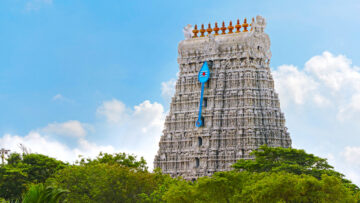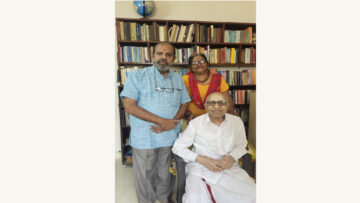असि सम्भेदतोगेन काशीसंस्थोऽमृतो भवेत्।
देहत्यागोऽत्रवैदानं देहत्यागोऽत्रवैतप:॥
(स्कन्दपुराणम्, काशीखण्डः)
asi sambhedatogena kāśīsaṃstho’mṛto bhavet।
dehatyāgo’travaidānaṃ dehatyāgo’travaitapa:॥
(Skanda Purāṇa, Kāśī-Khaṇḍa)
(One who has lived many lives and now dwells in Kāśī, united in the knowledge of ‘Asi Sambheda’, becomes like nectar—immortal. To give up the body in this sacred city is the highest offering, a supreme act of penance. It is a profound yoga, through which liberation is attained.)
Varanasi is the spiritual heart of India, where a cosmic story unfolds through its temples, ghats, and the sacred Maa Ganga. While the Ganga receives the reverence of saints, hidden gems are tucked away across Kashi’s ancient expanse. These gems are the sacred kunds (stepwells or ponds) that hold the echoes of stories, faith and centuries of spiritual practice. They are more than reservoirs, they are the cultural touchstones – each with its own legend, ritual significance and community memory. Among these are five notable kunds – Lolark Kund, Manikarnika Kund, Durga Kund, Lahartara Kund and Kapildhara Kund, each drawing on deep mythological roots and retaining continued cultural relevance.
Lolark Kund: A Sunlit Promise of Life
Figure 1: Lolark Kund – A Sunlit Promise of Life)
Tucked into the southern quarters of Varanasi near Tulsi Ghat, Lolark Kund is one of the city’s oldest sacred stepwells, intimately associated with Surya “Sun God”. The name “Lolark” means “Trembling Sun,” symbolizing the living power of sunlight reflected upon its ancient waters.
According to the Kashi Khanda of the Skanda Purana, this kund was formed when the Sun descended to earth to bless the infertile. Women who bathe in its waters on Lolark Shasthi, observed in the month of Bhadrapada (August–September), are said to be granted the boon of fertility. The ritual is deeply symbolic for women; newly married or women struggling to conceive would immerse themselves at sunrise in the Kund and leave behind clothes as well as personal items, which signifies the surrender of ego and renewal of hope.
The kund is architecturally rectangular with steep ghats and no visible inlet or outlet. During the annual fair, the steps are lined with fruits, garlands and diyas. Vendors sell trinkets and bangles, while priests chant mantras. On this morning, the quiet corner of the city becomes a vibrant vortex of devotion, maternal yearning and communal faith. Despite occasional neglect, Lolark Kund remains a shining reminder of how water bodies in Varanasi are not passive sites, but active agents of divine intervention.
Manikarnika Kund: Death and Moksha
(Figure 2: Manikarnika Kund – Death and Moksha)
Few places in Varanasi embody the confluence of death and liberation as powerfully as Manikarnika Ghat.At its heart lies the Manikarnika Kund, one of the oldest and most revered sacred waters in India. The kund is also said to have been created by Lord Vishnu with his chakra to welcome Lord Shiva and Parvati during their visit to Kashi. Thus, it is also known by the name “Shri Manikarnika – Chakra Pushkarini kund”.
Mythologically, it is believed that while watching the cosmic dance of Shiva and Vishnu, Parvati’s earring (mani) fell into this kund. Another version of stories says that, Vishnu’s chakra dug the kund and Shiva moved by his devotion shed the tear, thus sanctifying the spot as the convergence point of time and eternity. This kund, apart from being a ritualistic and metaphysical center, is also a Shakti Peeth.
Today, cremations take place just a few feet away. The sight of flames touching the air, ashes falling into the Ganga and monks meditating nearby can be overwhelming. But at the kund, the silence reigns. Pilgrims often pour milk or Ganga jal into the well seeking spiritual blessings. It’s a powerful paradox while the ghat exemplifies the end of life, the kund represents the timeless presence of birth.
Even in the face of rapid urbanization, the kund retains its spiritual gravity. It is not merely a pond, it is the womb of eternity where the soul promises to rise again.
Durga Kund: A Source of Feminine Power
(Figure 3: Credit: Wikimedia – Durga Kund – A Source of Feminine Power)
Located beside the iconic Durga Mandir, the Durga Kund is another significant water body of Varanasi, infused with feminine divinity and protective power. This square tank, now encased within railings and surrounded by flowering trees, was once directly connected to the Ganga through a canal system and was integral to temple rituals.
Constructed in the 18th century by Rani Bhabani of Natore, a prominent temple in Kashi built in Nagara style, the kund’s religious role is linked to a fascinating legend. According to folklore Goddess Durga appeared here to protect Princess Sashikala and her lover Sudarshan from royal opposition. The grateful devotees, in recognition of the goddess’ intervention, established both the temple and kund to celebrate this divine act.
The kund hosts rituals during Navratri, where thousands of women offer prayers, diyas and turmeric-colored water to honor Shakti. Children fly kites nearby while elderly women chant hymns at the edge of the steps. In a world where most sacred ponds are masculinized through associations with Shiva or Vishnu, Durga Kund stands out as a sanctified feminine space, a testament to divine protection and maternal love.
Recent conservation efforts have improved the structure and water quality, making it a rare example of a traditional kund surviving the tide of time, with both its spiritual and civic value intact.
Lahartara Pond: The Silent Song of Kabir
In the heart of Varanasi’s Lahartara area lies a largely forgotten, yet deeply revered pond, associated with one of India’s most profound spiritual voices Sant Kabir. According to legend, Kabir, a 15th-century poet-saint and mystic who was found as an infant floating on a lotus in this pond by a Muslim weaver couple Niru and Nima.
Lahartara Talab was a sprawling 17-acre lake. Pilgrims and Kabir Panthi followers would gather here to commemorate the saint’s birth, reflect on his teachings of universal love and offer prayers. The story of his miraculous appearance is more than myth which encapsulates the syncretic ethos of Varanasi, where Hindu-Muslim boundaries blur in the shared waters of faith.
At present only about 3.5 acres of it remain under conservation. The rest has been lost to encroachment, garbage dumping, and bureaucratic apathy. Yet every year on Kabir Jayanti, hundreds of devotees still arrive singing his couplets, lighting lamps and recalling his message that “Jal mein kumbh, kumbh mein jal hai” the divine exists both within and without. The pond, though diminished, continues to reflect the silent resilience of Bhakti, its waters carrying centuries of revolutionary devotion.
Kapildhara Kund: Where Sage and River Converse
Kapildhara Kund situated at the western edge of the Panchkroshi Yatra route, is closely linked with Kapila Muni, the ancient Vedic sage and philosopher known for founding the Samkhya school of thought. According to legends, Kapila meditated here and installed a Shiva linga Kapileshwar Mahadev beside a sacred pond that came to be known as Kapildhara.
Unlike other kunds in the city center, Kapildhara lies in much quieter surroundings, preserving its aura of retreat and contemplation. The kund was renovated in the 18th century by Queen Ahilyabai Holkar, a devout Shaivite. She ensured the upkeep of the water body and temple complex, thus making this kund an enduring part of Kashi’s sacred geography.
Pilgrims also halt here as a fifth halt of the Panchkroshi Yatra, bathing in its waters before proceeding to plant oat saplings in the Ganga at Jaun Vinayak. Locals believe that a dip in Kapildhara is as meritorious as offering pind-daan in Gaya. The kund therefore becomes a portal for purging ancestral debts and for closing a spiritual circle.
Even today, the stillness of Kapildhara invites not only devotees but seekers who come not to ask but to listen. To the murmur of water, the whispers of the stories and the unbroken mantra of an eternal city.
Circles of Devotion in Pools of Time
The kunds of Varanasi are not just bodies of water. They are vessels of memory, myth and meaning. Each tells a different story: of fertility and fire of death and rebirth, of feminine power, of Bhakti revolution, and philosophical depth. While some have been preserved with care, others have faded into obscurity, victims of neglect or urban expansion.
Yet, their spiritual energy endures. In a city where faith is not confined to form but flows like a river, these kunds are the city’s silent sentinels which hold up mirrors to the centuries of devotion faded and rising. They urge us not only to preserve them physically but to re-engage with them emotionally and culturally. As the Ganga continues to flow through Kashi, may the kunds continue to hold its echoes in still water, in sacred chants and in the hearts of all who listen.
Feature Image Credit: istockphoto.com
Disclaimer: The opinions expressed in this article belong to the author. Indic Today is neither responsible nor liable for the accuracy, completeness, suitability, or validity of any information in the article.












